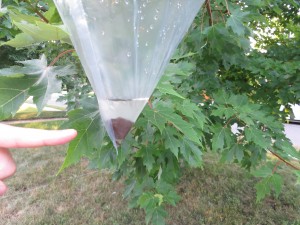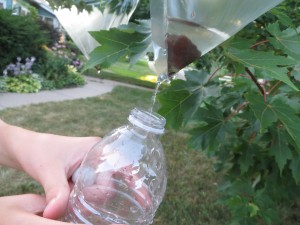Survival Science: Water Collection
- by KitchenPantryScientist
At the beginning of “The Hunger Games,” by Suzanne Collins, the heroine Katniss risks her life to retrieve an orange backpack and a sheet of plastic. In the backpack, she finds a black sleeping bag, a pack of crackers, a pair of dried beef strips, a bottle of iodine, a box of wooden matches, a small coil of wire, a pair of night glasses, a bottle of iodine and a half-gallon plastic bottle for carrying water. According to the book “Stay Alive,” by John D. McCann, she’s off to a pretty good start in terms of basic survival. He says that the following components should be included in any survival kit: fire and light, signalling, water and food collection, knives and tools, shelter and protection, navigation, and medical. I demonstrated how to do this experiment on Kare11. Click here to watch the clip.
The survival “Rule of Three” says that you can go 3 minutes without air, 3 hours without shelter (from heat or cold), 3 days without water and 3 weeks without food. That means that water is one of the first things you have to think about in a survival situation. Your body is about 75% water.
If it’s hot outside, you can easily collect water from non-poisonous leafy trees using a plastic bag. Clear works best, like a large oven bag. (Ours was for turkeys!)
Yesterday, we took 2 bags outside and put them over tree branches, enclosing as many maple leaves as we could and putting a small rock in the corner of each bag to weight them. Finally, we tied them around each branch securely with a twisty-tie. What else could you use if you didn’t have a tie? A shoelace? After 24 hours, we collected our water by cutting the corner of the bag and collecting it in a clear bottle.
Katniss had iodine to purify her water, but if you don’t have a water filter or iodine tablets to kill harmful bacteria, viruses and parasites, you could filter the clear water from plant transpiration through cloth, like a tee shirt or bandana, and leave it in a clear bottle in the sun for 6-10 hours to kill most pathogens. Don’t try drinking the water you get from this experiment, as it may not be safe!
Why to trees produce water? All plants carry water from their roots to small pores called stromata on the underside of their leaves. These pores release water into the air in a process called transpiration. Transpiration helps cool plants, but is also involved in moving nutrients from root to leaf. Plants transpire the most on hot, dry days and trees that have gotten plenty of water give off the most water. According to the U.S. Geological Survey, a large Oak tree can transpire 40,000 gallons of water a year! Our area is very dry at the moment. We probably could have collected more water from our tree following some rain!
So, as of today, our survival kit will include a pocket knife, a clear plastic oven bag, and a bandana. What should we add next?


